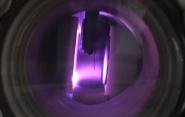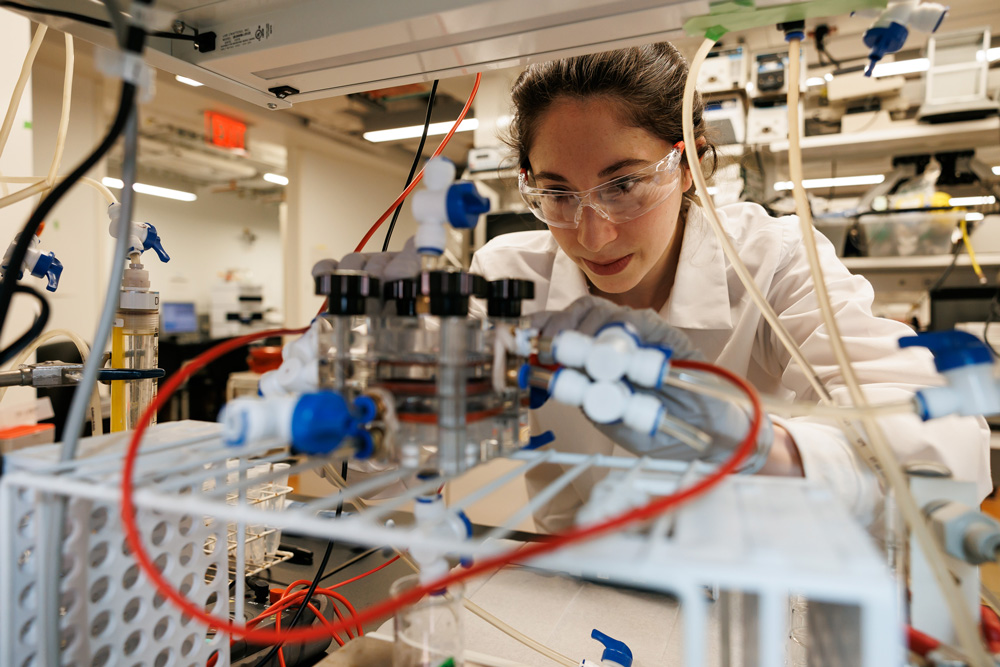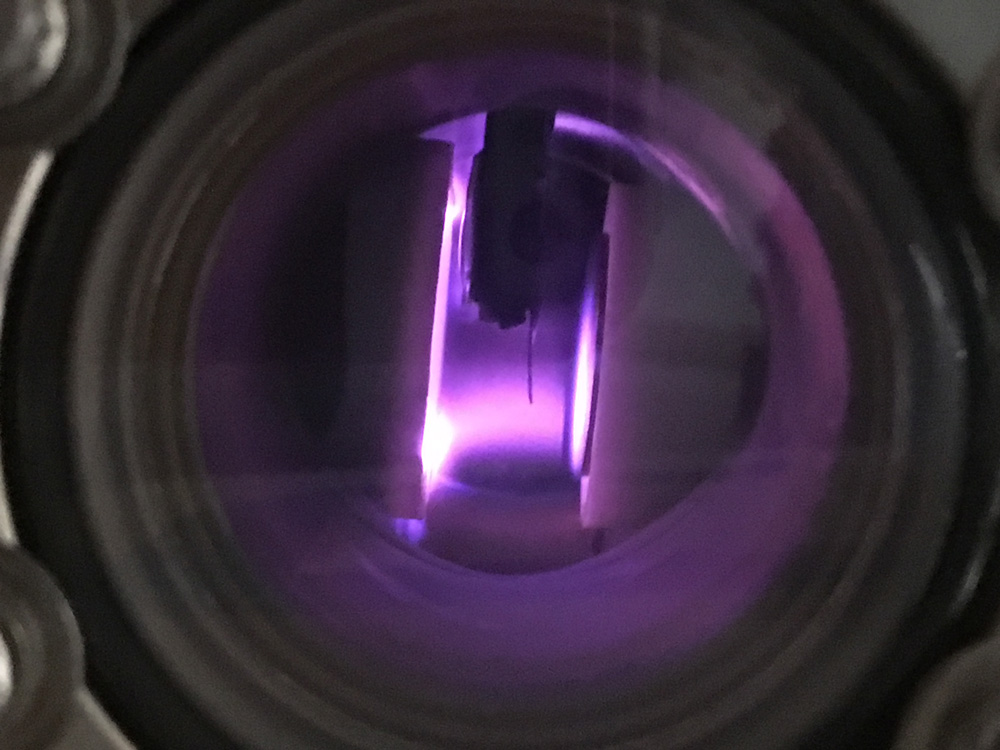Electrified Processes at the Intersection of Water, Energy & Climate

Lea Winter joined the Yale's Department of Chemical and Environmental Engineering this past July as an assistant professor. Born and raised in New Haven, she is excited to continue her career at Yale, where she previously completed her undergraduate degree and a postdoctoral fellowship.

Eleven years ago, she began her academic journey as an aspiring chemical engineering major. Throughout her four years at Yale, she explored different research topics under summer research fellowship opportunities, ranging from immuno-genomics to alternative fuels. She spent part of her academic career under the mentorship of Dr. Menachem Elimelech, whose research centers around developing membranes for water treatment technology. Winter's involvement in sustainability research fostered her interest in environmentally-focused research to preserve human health.
"I realized that people get sick because of a lack of access to clean water, malnutrition, air pollution, extreme climate events relating to climate change...I wanted to work on these environmental issues to prevent these situations from happening," Winter said. "I wanted to increase access to clean water, or increase access to fertilizer and ways to improve food security, or try to mitigate climate change to prevent catastrophic climate events from happening."
After completing her degree at Yale in 2015, she began her Ph.D. in Chemical Engineering at Columbia University under the mentorship of Dr. Jingguang Chen, who researches heterogeneous catalysis and electrocatalysis to improve chemical manufacturing processes.
Throughout her graduate career, she developed electrically-driven pathways to generate chemicals from sustainable inputs. Many industrial processes that produce consumer goods are indirectly driven by fossil fuels: for example, conventional alcohol production is reliant upon hydrogen, which is largely sourced from natural gas and coal, as a key reactant. As an alternative, alcohols could be made by reacting CO2 with ethane, an underutilized compound extracted with natural gas, as the hydrogen source to generate alcohols. This reaction cannot occur using heat-driven processes, but it is achievable using an electricity-based plasma process at room temperature and ambient pressure.
"It's possible that the best way to find electricity-based processes isn't just to take the same reaction and run it on electricity [instead of heat], but instead to do it in an entirely different way, or even to have different inputs in the process," she said. "And by changing those details for how we do the process, we might be able to find more efficient routes to making these products." In her graduate research, she targeted carbon dioxide as a reactant to generate fuels and chemicals widely used in industrial processes.

As she was finishing her Ph.D. at Columbia, she began applying for postdoctoral fellowships that complemented her research in energy and sustainable inputs. She soon discovered that researchers in the Elimelech Lab were beginning a project coupling membranes and electrically-driven phenomena. Applying her expertise in heterogeneous catalysis and plasma catalysis, Winter rejoined the Elimelech Lab in 2020 to develop electrified membranes.
Conventional membranes do not break apart contaminants in water supplies, but rather separate these from a target stream. As a result, membranes produce a "waste stream" that must be disposed of, running the risk of recontaminating water supplies. In contrast, electrified membranes are advantageous because they can both capture and degrade contaminants into harmless byproducts.
"It was serendipitous," Winter said. "I had this idea about making membranes that could do electrochemistry, and there were people in the Elimelech Lab who were thinking of writing a review paper on that topic at the same time. I had read a paper from the Elimelech Lab on using photocatalysts in membranes to degrade contaminants. You need to somehow deliver the solar energy to photocatalysts in water. Imagine coating a membrane with a catalyst: that membrane needs to be exposed to the water, and be exposed to sunlight. The reaction might be limited by how much sunlight can get to the membrane surface under the water."
Traditional technologies have used photocatalysts, particles that use light to jumpstart electron-based reactions, to degrade contaminants. However, these catalysts are reliant upon light exposure, limiting their use in industrial facilities to the daytime. In contrast, conventional water treatment systems are running at all hours of the day to constantly supply clean water to the general public.
The electrified membranes that Winter is developing decouple the renewable energy capture from the catalytic reaction. By using a conductive membrane, electricity can be transferred from an external source, extending the hours that these membranes can be used in industry.
"I thought -- what if we were to decouple the solar radiation capture from where the reaction is happening? In other words, what if we were to separate out the solar panel from where the catalysis is happening?"
Already, the Winter Lab has an ambitious group of researchers who are collaborating with centers both internally and externally, such as the Yale Center for Natural Carbon Capture and the NSF's Nanosystems Engineering Research Center for Nanotechnology Enabled Water Treatment (NEWT), a collaboration that spans across four different universities to improve methods for water treatment technology. Her research will focus on water treatment technologies, a traditional strength of the Yale Environmental Engineering program, as well as energy storage, resource loops, and electrically-driven processes.
As an environmental engineering faculty with a chemical engineering background, she seeks to utilize traditional chemical engineering principles towards challenges that the environment is facing. In the upcoming academic year, Winter is planning on teaching courses such as the Water Energy Nexus and Engineering Solutions to Climate Change to better prepare environmental engineers to tackle issues relating to climate change.
In the span of eleven years, when she began her undergraduate career at Yale, the Department of Chemical and Environmental Engineering has changed drastically. Many faculty members that taught her courses have left or retired, and new professors with novel research areas have joined the faculty. Still, she notes that the spirit of Yale's engineering departments, which she hopes to contribute to throughout her future career as a Yale professor, was as she remembers it.
"Something that I learned from my peers when I was a Yale undergraduate: follow your passions," Winter said. "When I was a Yale undergraduate, people tended to work on things that they were passionate about, and that's something which I think is really important. If you work on something you're passionate about, you'll enjoy it, and you'll do it well."
Kevin Pataroque (He/Him/His) is a second year Environmental Engineering Ph.D. student in the Elimelech Lab. A recent graduate of Case Western Reserve University, Kevin seeks to make scientific research accessible and relevant beyond the laboratory. His research areas include desalination processes, membrane technology, and clean water equity.

